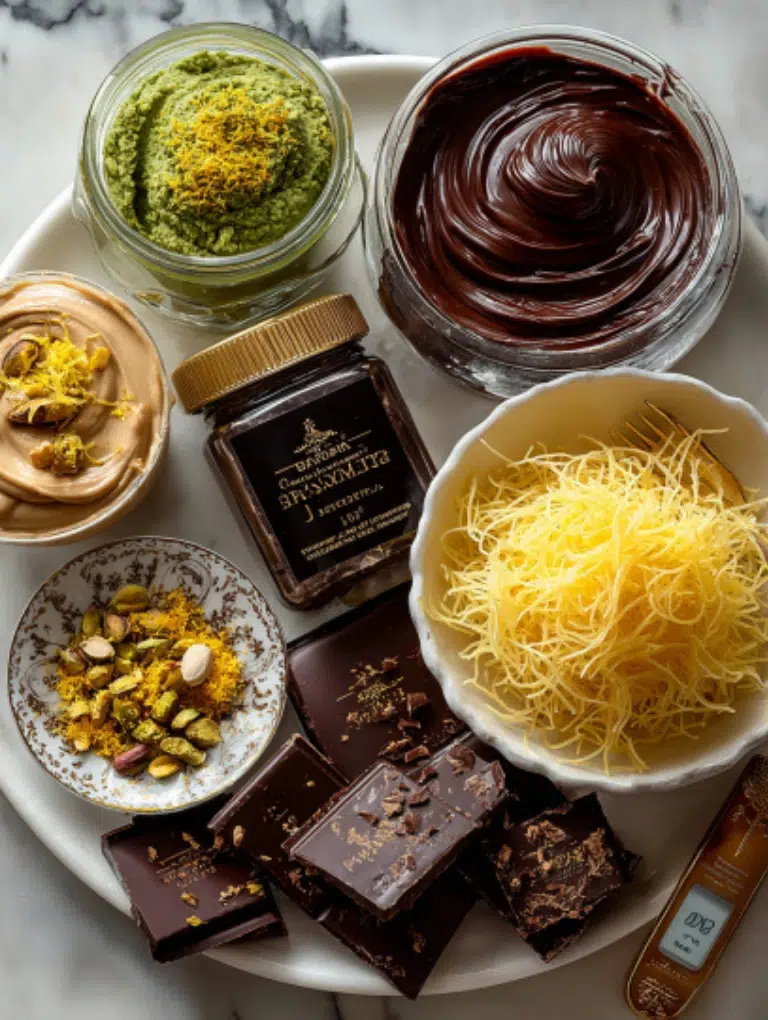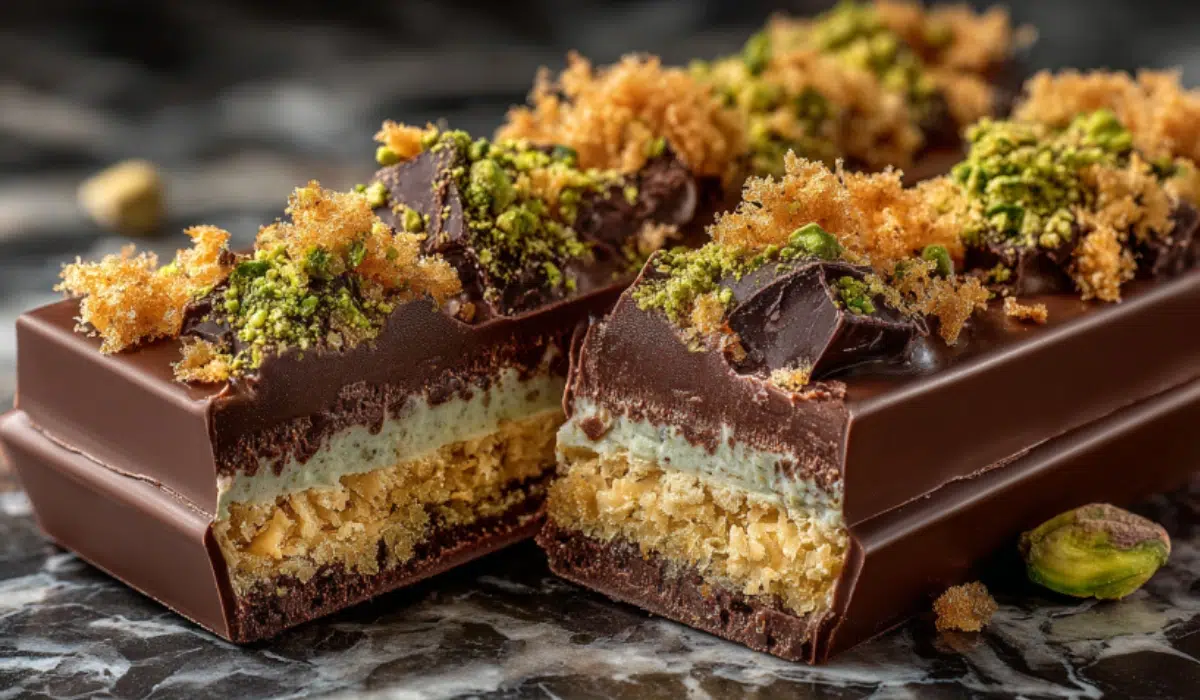Bake Master Dubai Chocolate has become one of the most talked-about sweets online, and for good reason. Imagine a crisp chocolate shell that snaps cleanly, giving way to layers of creamy pistachio, smooth tahini, and crunchy kataifi. The result is a bar that blends Middle Eastern tradition with modern chocolate-making techniques.
In this guide, you’ll learn exactly how to make Bake Master Dubai Chocolate at home with professional methods that guarantee shine, snap, and flavor. From choosing the right ingredients to mastering tempering, molding, and flavor layering, this article will help you create a bar that looks as good as it tastes.
Table of Contents
Ingredients & Equipment for Bake Master Dubai Chocolate Recipe

To make Bake Master Dubai Chocolate successfully, you need both quality ingredients and the right tools. Cutting corners here often leads to dull shells, soft centers, or uneven texture.
Best Chocolate Types
Choose couverture chocolate with at least 31 to 35 percent cocoa butter. This helps achieve the glossy finish and sharp snap. Milk chocolate is most common for the shell, but dark or white chocolate also work depending on your taste.
Filling Elements
- Pistachio paste: Smooth, rich, and nutty, this forms the heart of the filling.
- Tahini: Adds a subtle sesame depth that balances sweetness.
- Kataifi (or shredded wheat): Toasted strands create crunch in every bite.
- Citrus notes: A touch of orange zest or candied peel lifts the richness.
Essential Tools
- Chocolate molds: Polycarbonate molds give a professional finish and sharp edges.
- Digital thermometer: Crucial for tempering to precise temperatures.
- Offset spatula: For spreading chocolate evenly and scraping excess.
- Piping bag: Helps with clean filling placement.
- Kitchen scale: Keeps ingredient ratios accurate.
Sourcing in the US
Specialty ingredients like kataifi and pistachio paste are available in Middle Eastern or gourmet grocery stores. Many chocolate suppliers online carry couverture chocolate in various percentages.
Step By Step Method for Bake Master Dubai Chocolate Recipe
Prepare the Crunchy Layer
Preheat the oven to 160°C (320°F). Toss the kataifi strands with a little melted coconut oil, then bake until golden. If you’re using shredded wheat, you can skip the baking step. Let it cool before mixing.
Make the Pistachio Cream
In a bowl, combine pistachio paste with tahini. Stir until smooth, then add orange zest, candied orange, vanilla bean powder, and a pinch of salt. Fold in the cooled kataifi to form a textured filling.
Temper the Chocolate
Melt couverture chocolate gently over a bain-marie or in short microwave bursts. Use the seeding method to bring the temperature down to around 30–31°C for milk chocolate, 31–32°C for dark, and 28–29°C for white, as outlined by the Callebaut Chocolate Academy.
Cast and Fill the Shells
Pour tempered chocolate into the mold, tap to release air bubbles, then invert and scrape off excess, leaving a thin shell. Let it set. Spoon or pipe the filling into each cavity, leaving a few millimeters at the top.
Seal and Chill
Cover the filling with a final layer of tempered chocolate. Scrape away excess with your spatula, then let the bars set fully at room temperature or in a cool environment. Unmold once firm.
Snap Test
A properly made Bake Master Dubai Chocolate bar should break with a clean snap, reveal even layers, and have a glossy surface.
Professional Techniques
Tempering Targets and Fixes
Tempering is the backbone of a successful bar. For milk chocolate, aim for 30–31°C. If you overshoot, add a few unmelted chunks and stir to bring the temperature down. This keeps the cocoa butter crystals stable.
Shell Thickness
A thin shell cracks easily, while a thick one overwhelms the filling. Aim for about 2 mm thickness. Tap the mold after pouring to even out the coating and avoid hollow spots.
Layering for Balance
Spread the filling evenly without pressing too hard. This keeps the kataifi strands crunchy and avoids air gaps. Layering is about harmony between creaminess, crunch, and chocolate snap.
Clean Finish
After sealing the mold, scrape the surface with a metal scraper in one motion. This prevents messy edges. For shine, let the bars set at a steady, cool room temperature instead of rushing them in the fridge.
Storage, Shelf Life, And Shipping
Room Temperature vs Fridge
Storing chocolate in the fridge or exposing it to sudden temperature shifts can cause sugar bloom an unappealing surface haze due to condensation and recrystallization of sugar, as Callebaut’s guidance confirms.
Melt Risk in Summer
In hotter months, chocolate is prone to melting during transport. If you plan to ship, pack bars in insulated boxes with cold packs. Avoid direct sunlight or leaving them in cars.
Allergen and Nutrition Notes
These bars contain nuts, sesame, and dairy, which are among the major allergens listed by the U.S. Food and Drug Administration. They are rich in calories, so a small serving goes a long way. Adding detailed nutrition info helps readers understand portion sizes.
Troubleshooting
Cracking or Hollow Shells
This usually happens when the chocolate cools too quickly or the shell is too thin. Keep molds at room temperature and make sure the coating is even.
Fat Bloom or Sugar Bloom
White streaks or spots appear when tempering fails or the chocolate is stored in a humid place. Re-temper the chocolate and store it in a cool, dry environment.
Soft Shells and Leaking Fillings
Too much moisture in the filling can soften the shell. Dry ingredients like kataifi before mixing and leave a margin at the top of the mold before sealing.
Uneven Texture or Dull Finish
This often comes from skipping proper tempering or rushing the setting process. Take your time with the temperature curve and let the bars set naturally.
Expert Tips
Flavor Pairing Ideas
Pair pistachio and tahini with rose water, cardamom, or even a sprinkle of sea salt for an aromatic twist. These accents lift the richness without overpowering it.
Batch Planning
If you’re making bars for an event, plan in stages. Toast the kataifi a day ahead, prep the pistachio filling early, then temper and mold the chocolate closer to serving.
Serving Style
For a photo-ready presentation, slice bars with a warm knife to show off the layers. Arrange on a simple platter to highlight the glossy finish and crunchy interior.
Advanced Variations
Dark, Milk, and White Shells
Switch the shell type to match your flavor preference. Dark chocolate brings a stronger cocoa edge, milk adds balance, and white offers a sweeter contrast to pistachio and tahini.
Flavor Twists
Swirl tahini into the pistachio paste for a marbled effect, or fold in chopped nuts like hazelnuts and almonds. Dried fruits such as cranberries or apricots add chewiness and color.
Alternative Formats
Instead of bars, pour the mixture into silicone cups for individual portions. You can also spread the layers onto a tray and cut into slabs for easy gifting.
Buying Guide In The US
Sizes to Consider
Bake Master Dubai Chocolate often comes in 60 g snack-size bars or larger 190 g slabs. The smaller size is handy for sampling, while the bigger bar works well for sharing or gifting.
Authenticity Checks
Since viral products attract dupes, check packaging carefully. Look for clear labeling, ingredient lists, and seller credibility. Reputable retailers usually specify storage conditions and shipping details.
Price and Freshness
Expect to pay a premium for authentic imports. Prices vary by pack size, but freshness matters more. Always check best-before dates and return policies before buying online.
Conclusion
Bake Master Dubai Chocolate combines professional technique with indulgent flavor, making it more than just a sweet treat. With the right ingredients, careful tempering, and a few expert tricks, you can create bars that rival the originals in shine, snap, and taste. Whether you stick to the classic pistachio and kataifi filling or branch out into creative variations, the result is always impressive.
If you prefer to buy rather than make, knowing what to look for in size, freshness, and authenticity ensures you enjoy the real experience. Either way, Bake Master Dubai Chocolate is proof that attention to detail turns a simple bar into something unforgettable.
FAQ about Bake Master Dubai Chocolate
What chocolate type gives the best snap for Bake Master Dubai Chocolate?
Couverture milk chocolate with high cocoa butter content gives the cleanest snap and glossy finish.
How can I temper chocolate at home without special tools?
Use the seeding method with a microwave or double boiler, and monitor with a digital thermometer for accuracy.
How thick should the shell be to keep a clean snap and neat edges?
Aim for about 2 mm thickness. This keeps the shell strong enough without overwhelming the filling.
What can I use if I cannot find kataifi or kunafa locally?
Shredded wheat or crisp rice cereal makes a suitable substitute for texture.
How do I stop the filling from leaking or making the shell soft?
Leave a small margin at the top of the mold, use well-dried crunchy elements, and seal with a solid layer of tempered chocolate.
How long does Bake Master Dubai Chocolate last and how should I store it?
Stored in a cool, dry place, the bars keep for about two weeks. Avoid refrigeration unless necessary, and always store in airtight containers.
Can I ship these bars in warm weather without melting?
Yes, but pack them in insulated boxes with cold packs and avoid long exposure to heat.













